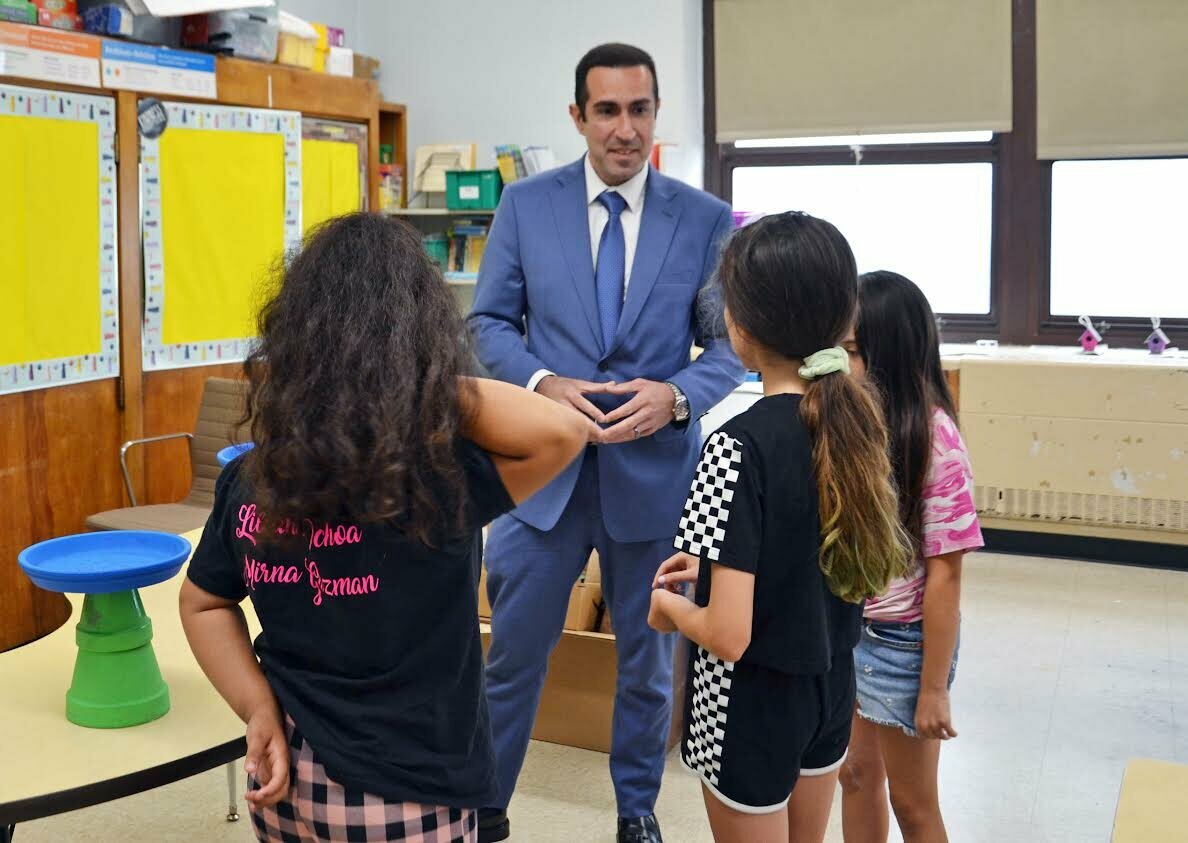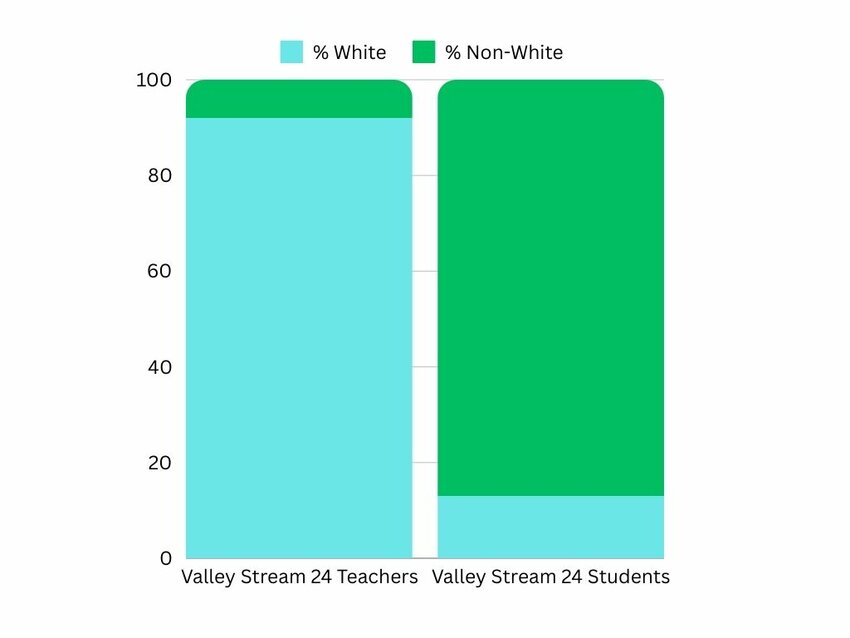Valley Stream District 24 doubles down on diversifying teaching workforce, explained.
For years, local education policy experts have lamented an ongoing trend that while Long Island’s student population is becoming increasingly ethnically and racially diverse, the same cannot be said for the Island’s teaching staff.
It’s a serious problem for administrators like Valley Stream District 24 Superintendent Unal Karakas, who oversees a district where roughly 87 percent of students are students of color, according to the latest state education data, but only a fraction of teachers are non-White.
“Our students come from so many different backgrounds, so many different religions, and different subgroups of learners, such as students with disabilities,” said Karakas. “Having diversity reflected in our teaching force allows students to, you know, see themselves in those that are in our classrooms or leadership.”
The Takeaway
- Despite Long Island's increasingly diverse student population, the teaching staff remains predominantly white, posing a challenge for administrators like Valley Stream District 24 Superintendent Unal Karakas where only a fraction of teachers are from minority backgrounds in a majority minority student district.
- Karakas is spearheading efforts to diversify the teaching staff by exploring new recruitment methods. He plans to personally attend a career recruitment fair at Howard University, a historically black college, to actively engage with potential minority candidates.
- Beyond recruitment, education experts emphasize the importance of creating inclusive work environments where minority teachers feel supported and valued. Efforts to recruit must be complemented by strategies to integrate minority hires into the community and ensure their professional fulfillment to prevent turnover.
Generated through Open-AI
Pent-up demand for more minority teachers in 2020 soon led to the creation of a Diversity, Equity, and Inclusion committee, the first of its kind in the district. However, the ostensible lack of considerable progress concerning one of the group’s founding goals—diversifying the teaching staff—has pushed Karakas to try new ways of recruiting minority talent.
A new playbook in diversity hiring
“I’ve done a lot of reflecting on this,” he said, who, as of press time, told the Herald he will be sending himself to Washington D.C. to attend a career recruitment fair at one of America’s best-known historically black colleges: Howard University.
There, he plans on shaking hands, exchanging business cards, and showing a friendly face to scores of educational job candidates, making the case for why they should join the staff team at Valley Stream District 24.
“We value diversity,” Karakas said, “so our goal is to expand our recruitment candidate pool to as many diverse candidates as possible by reaching out to those who may not have previously thought about applying to our district.”
A minority educator of Turkish descent and a product of a diversity leadership mentorship program, Karakas may just be especially suited to speak to possible hires in a language they can understand — in a way that makes them feel seen. His in-person appearance, he hopes, will hammer home to them just how seriously his district values having diverse, qualified teachers on its staff.
“This is the first time we’re partnering up and sharing our job postings with a historically black college and the first a superintendent from District 24 will be there to speak with candidates,” said Karakas.
Going the extra mile to court caliber minority candidates, Karakas says, presents prospective hires with reassurance that a school district is committed to diversity and inclusion — and is willing, even anxious, to embrace new hiring strategies to get minority teachers through the door.
“We hope this will offer those HBC students, who originally reside near the Valley Stream area but go to college out of state, to say this is a district I want to work for after graduation,” said the superintendent since most of the job candidates who apply tend to live locally. “But it also offers the opportunity for anyone who doesn’t live in the area to potentially be interested in relocating here once they get a sense of the diversity that’s truly present here.”
It’s also a tacit reality check that perhaps more mainstream recruitment tactics need an outside the box approach. Normally, the hiring process in District 24 begins online, not face-to-face. “Anytime we conduct or place a job posting, we also post it on what’s called Handshake, (a recruiting software), which colleges and universities then disseminate to candidates who are interested in applying, but we have to partner with those colleges and universities first,” said Karakas, who said the district partners with roughly 30 colleges and universities.
“Not every college and university utilizes Handshake, however,” said Karakas. “Howard University wasn’t.”
Mainstream forms of outreach may just rely too heavily on candidates making the first move and submitting their résumés through a mostly impersonal process. If the goal is to seek out diverse prospective hires, argued Karakas, it falls on the school district, especially ones where minority teachers are scarce, to show that their district is a correct match for minority applicants.
“You wouldn’t get that from a posting,” Karakas said. “It’s up to us to have the right messaging, share what we have to offer, and say to candidates, we’re here for you and here to support you.”
Recruit, retain, repeat
While roughly 77 percent of the state’s teachers are White, the market for minority candidates is there amid increasing graduation rates of minority professionals, but districts need to invest in what Karakas described as “front-and-center messaging” around diversity hiring.
On top of throwing his energy into more direct, personable forms of outreach, Karakas also uploaded a job recruitment video on the district’s main page listing reasons why minority hires should join the district.
Education experts note there’s more to minority hiring and recruitment than districts having attractive offerings on the usual list of career demands around pay, employee benefits, state certification, and opportunities for career advancement.
A school district needs to understand minority hires’ fears and hesitations about how they will thrive in a workplace where they are in the minority.
“Recruitment is only half of the equation in making sustainable inroads in teacher hiring inequities if even that,” said Larry Levy, the executive dean of Hofstra’s National Center for Suburban Studies. That second half is retention.
“A lot of school districts recruit minority teachers and they are either one of very few, or they are coming from places that are very different than the communities on Long Island,” said Levy. “Districts have to be prepared to put a lot of effort into making teachers feel part of the community and practice their profession in ways that are fulfilling.
“If you don’t,” he added. “you’re going to lose them.”
Have an opinion on this article? Send an email to jlasso@liherald.com.

 69.0°,
Partly Cloudy
69.0°,
Partly Cloudy 





